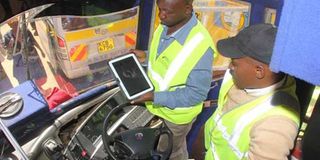Breaking News: At least 10 feared to have drowned in Makueni river
No need for new traffic laws or agencies

NTSA officials conduct a random check on a bus to ensure compliance with speed and traffic rules. PHOTO | JARED NYATAYA | NATION MEDIA GROUP
What you need to know:
- Erecting speed bumps to manage speeding is akin to using reinforced steel and concrete walls to manage robberies, yet this is evidence of a gap in law enforcement.
- In 2009, President Mwai Kibaki described traffic law enforcement as “very lousy” during a conference on road safety at the Bomas of Kenya.
- New efforts should be focused on ensuring that there is a semblance of driving on our roads by deliberately and, if need be, forcefully creating a critical mass of conscientious drivers.
- Fatigue, overtaking on blind corners or overlapping do not constitute unforeseeable factors beyond human control.
Even the most optimistic analysis of safety on our roads will lead to one inescapable conclusion: That the current situation is untenable. Our approach to road safety has been reactive rather than proactive. For instance, erecting speed bumps to manage speeding is akin to using reinforced steel and concrete walls to manage robberies, yet this is evidence of a gap in law enforcement.
In 2009, President Mwai Kibaki described traffic law enforcement as “very lousy” during a conference on road safety at the Bomas of Kenya.
He directed the relevant agencies sort out this mess once and for all. In a simplistic approach, the solution was found to be a new law and a new agency, the NTSA. With the latest spate of accidents, talk of new laws, new agencies and new individuals is once again in the air.
However, for those armed with some basic knowledge in law enforcement, we know that road safety is a direct product of diligent and informed enforcement of driving standards as encoded in road traffic laws and regulations.
TRAFFIC LAW
Indeed, the sole objective of everything about roads from design to regulations to traffic law is moving people and goods safely and on time.
Unfortunately, there is just very little driving in Kenya. We have plenty of gear, steering wheel, accelerator and brake pad operators on our roads but very few drivers.
New efforts should, therefore, be focused on ensuring that there is a semblance of driving on our roads by deliberately and, if need be, forcefully creating a critical mass of conscientious drivers.
Driving has been defined as a “person of sound physical and mental health taking actual physical control of a motor vehicle”. A mad person cannot exercise actual physical control of himself leave alone a vehicle. Corporal Wanjohi (who was my instructor years ago) placed one caveat on this definition: All driving is predicated upon the driver’s appreciation of the nature of the road, the amount of traffic and the condition of the vehicle.
PASSENGERS
A driver who is unable to keep to his lane, drops and picks passengers in the middle of the road or is demonstrably incapable of responding to the cautionary, regulatory and safety signs on the road is not possessed of the required level of intelligence.
He is, therefore, mentally unfit to drive on a public road and must be removed, but not after he has killed people! His license should be cancelled and his details placed on a public platform so that whoever allows him to drive can be punished by law.
Even the 1964 independence Traffic Act had explicit provisions to enforce that. Nobody needs to procure a digital driving licenses or hold a dozen press conferences on the subject. We just need to act.
The dictionary meaning of the word actual includes “true” or “real”. How then do you determine whether one is actually, truly or really driving?
Up to the time when self-driven vehicles take over the roads, automotive engineering and road design will continue expending much thought on control of these thrilling machines to achieve relatively predictable safety standards.
LOSE CONTROL
Actual physical control of a vehicle is that situation where a driver combines the nature of the road, the amount of traffic and the type and condition of vehicles to ensure that the vehicle cannot do anything he has not consciously and deliberately caused it to do, including ramming head-on into an oncoming truck.
A driver who losses control of his vehicle cannot claim to have been driving unless there is evidence that he was denied the physical control by unforeseeable factors beyond his control.
Fatigue, overtaking on blind corners or overlapping do not constitute unforeseeable factors beyond human control. These are acts in the realm of premeditated murder.
Drivers who must be controlled by road bumps or regulation of driving hours cannot be termed as drivers.
Instead of changing laws, introducing new driving licenses or creating new agencies, the solution is simple; agencies involved in traffic management must urgently train every law enforcement officer on what the highway code is intended to achieve and they must also remove mad people purporting to be drivers from our roads.
Mr Kiraithe is the government spokesman. [email protected]





